

Add contemporary camera systems to Leica M series microscopes and tap into the powerful features of state-of-the-art cameras with our LM adapters
Stereomicroscopes are used in industrial, laboratory and healthcare environments to observe large objects. From performing quality checks of electronic components to analysing biopsy samples or zoological specimens: these tasks frequently require low magnifications and a large working distance.
With our LM microscope adapters, an extensive range of digital cameras, such as conventional DSLR cameras, mirrorless system cameras and hybrid cameras, C-mount microscope cameras, C-mount industrial cameras or high-speed cameras, can be attached to the microscope. Our LM microscope adapters are quality products, developed and manufactured in Austria. The adapter solution is equipped with an integrated optical system for optimising the field of view, which facilitates the best possible image quality.
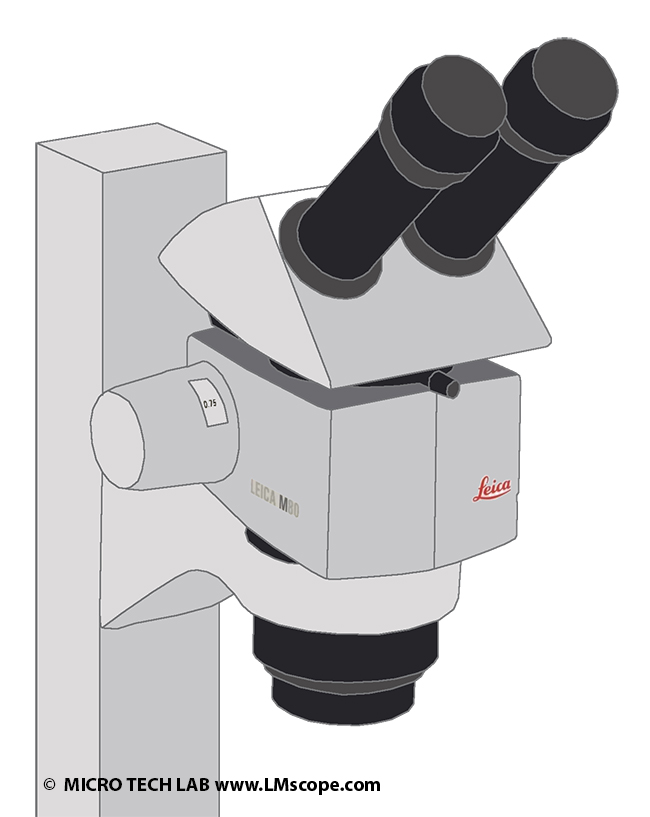
Leica’s M series comprises three “telescope style” (Abbe principle) stereomicroscopes: the M50, M60 and M80. Microscopes having this design are better suited for photographic work than stereomicroscopes with a Greenough optical system. This design uses a single large diameter objective lens with two parallel beam paths. Because both beam paths (left and right) share one objective lens, the microscope must have a high-quality main objective with a large lens diameter.
Overview of key features:
• Stereomicroscope with telescope optical design
• Magnification range approx. 6.3x to 128x
• Maximum numerical aperture 0.206 (M80)
• Zoom factor 5:1, 6:1 or 8:1
• Supplementary lenses 0.32x. 0.5x, 0.63x, 0.8x, 1x, 1.25x, 1.6x, 2x (achromats) as well as 1x and 1.6x (plan) are available
• Working distance with standard optics (1x objective): 89.6 mm (achromatic 1x) or 83.4 mm (plan 1x)
Leica microscopes are known for their high-quality optical components, and this extends to their M series microscopes. All objectives use the same reference focal length as the objectives of the previous (MZ) generation and have an external diameter of 58 mm, ensuring that any objectives from previous Leica stereomicroscope series can continue to be used.
The M series uses zoom optics with factors that correlate with the model name: 5:1 for M50, 6:1 for M60 and 8:1 for M80. Magnification ranges between 6.3x and 128x, and five defined step magnification levels – 6.3x, 10x, 16x, 25x and 40x – offer a standardised set of magnification points that can be easily replicated across different observations or by different users. The zoom factor can be changed while looking through the eyepieces, and a click (“click-stop”) indicates that the microscope has reached a predefined magnification level.
The standard objective is an achromatic 1x objective lens. By combining achromatic or plan objectives and the eyepieces (10x to 40x), total magnifications of up to 320x can be achieved. Depending on the magnification, the object field of view ranges between 5.75 mm and 36.5 mm in the standard configuration. The maximum object field is a circle with a diameter of 116.8 mm. Working distance is particularly significant when dealing with large specimens. An achromatic lens provides the largest working distance (303 mm at 0.32x).
The choice of illumination is another important aspect when it comes to image quality. The M series microscopes can be equipped with an LED ring illuminator that uses an LED auxiliary lens specially developed by Leica. Other illumination options are an oblique incident light illuminator (LED MCI) and a highly flexible double-armed gooseneck illuminator.
The most convenient way of capturing high-quality images of specimens is to attach the camera to the phototube of the microscope. For this purpose, Leica offers a beam splitter (video/photo port) with an M38 thread, which is placed between the main microscope body and the binocular tube.
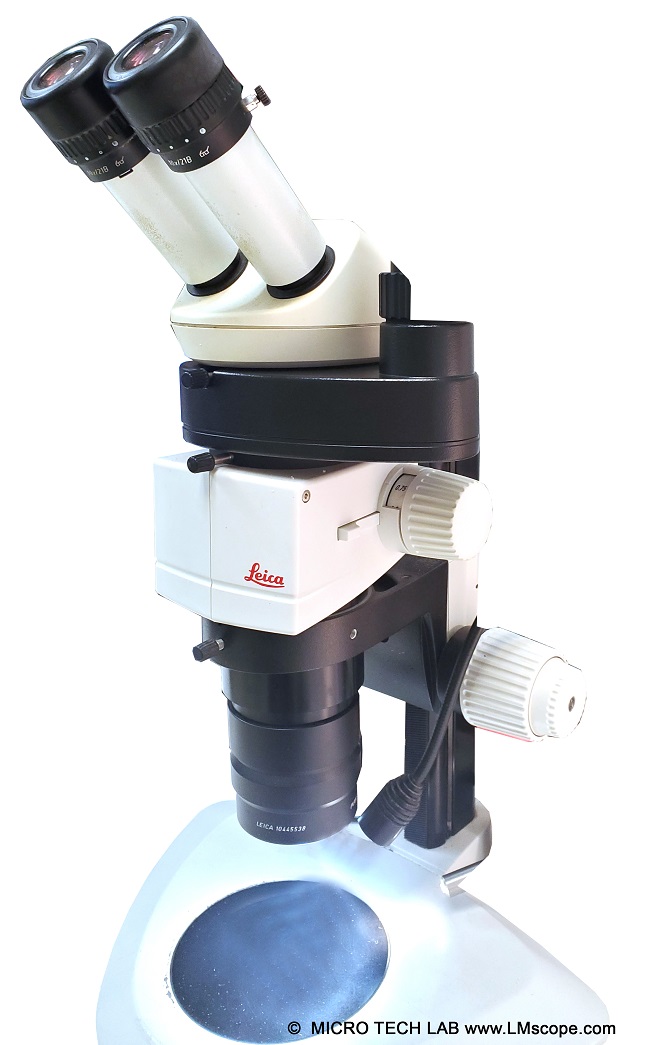
Depending on the distribution of light, there are two specifications: 50% : 50% (HD F10 446 308) and 100% : 0% (HD V10 446 309) The LM adapter solution is attached to the beam splitter and the camera is mounted on top of the adapter. With our LM microscope adapters, an extensive range of digital cameras, such as conventional DSLR cameras, mirrorless system cameras and hybrid cameras, C-mount microscope cameras, C-mount industrial cameras or high-speed cameras, can be attached to the microscope. Our LM microscope adapters are quality products, developed and manufactured in Austria. The adapter solution is equipped with an integrated optical system for optimising the field of view, which facilitates the best possible image quality.
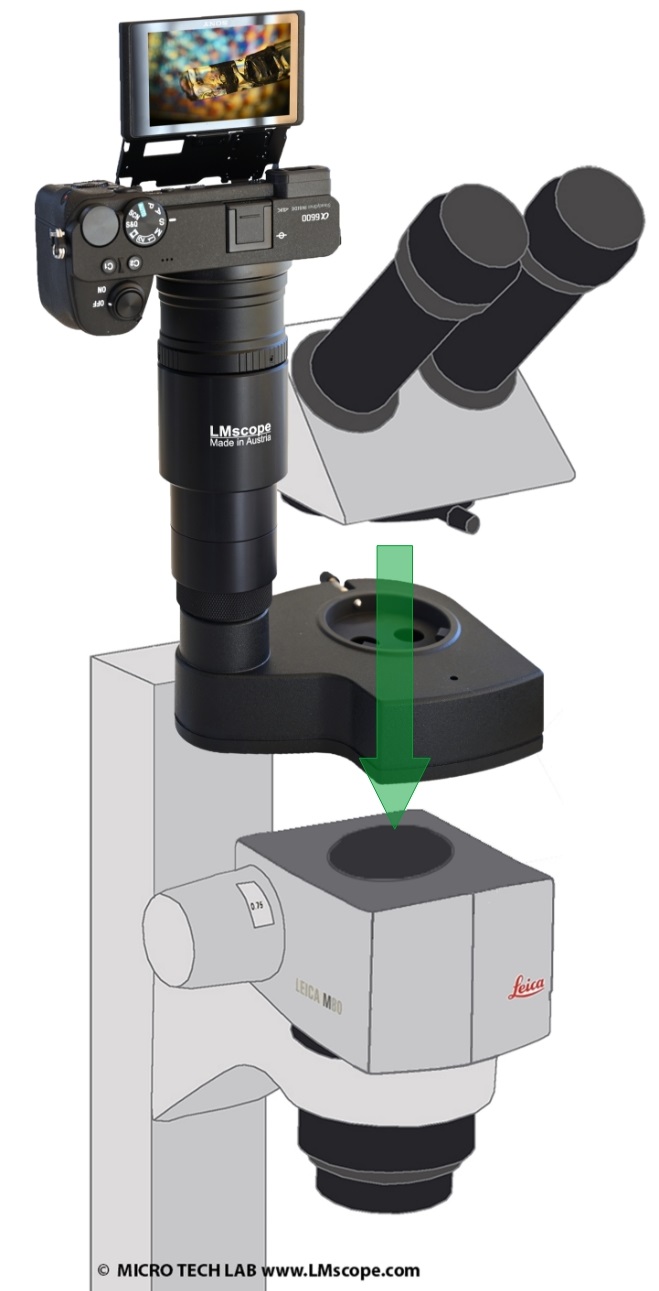
Alternatively, a video/photo tube (item no. 10 445 925 or 10 446 310) can be attached directly to the main microscope body.
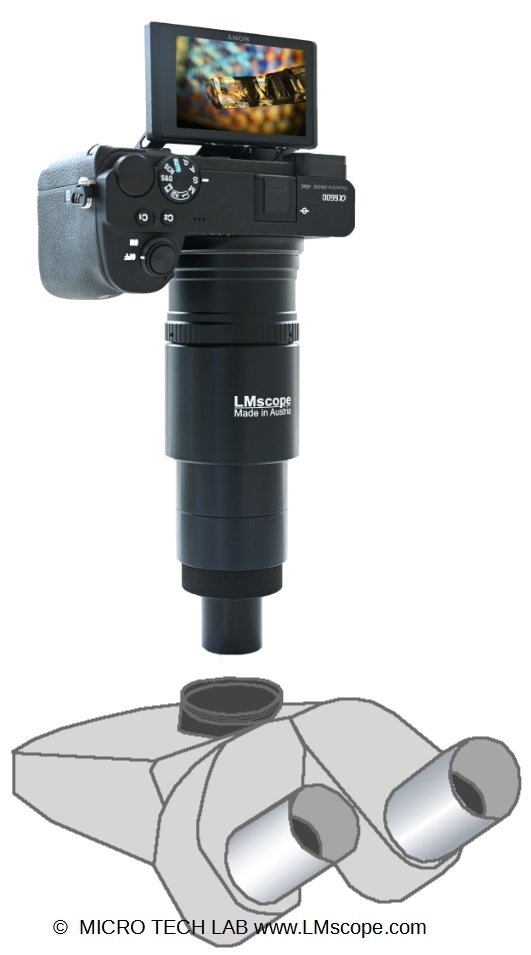
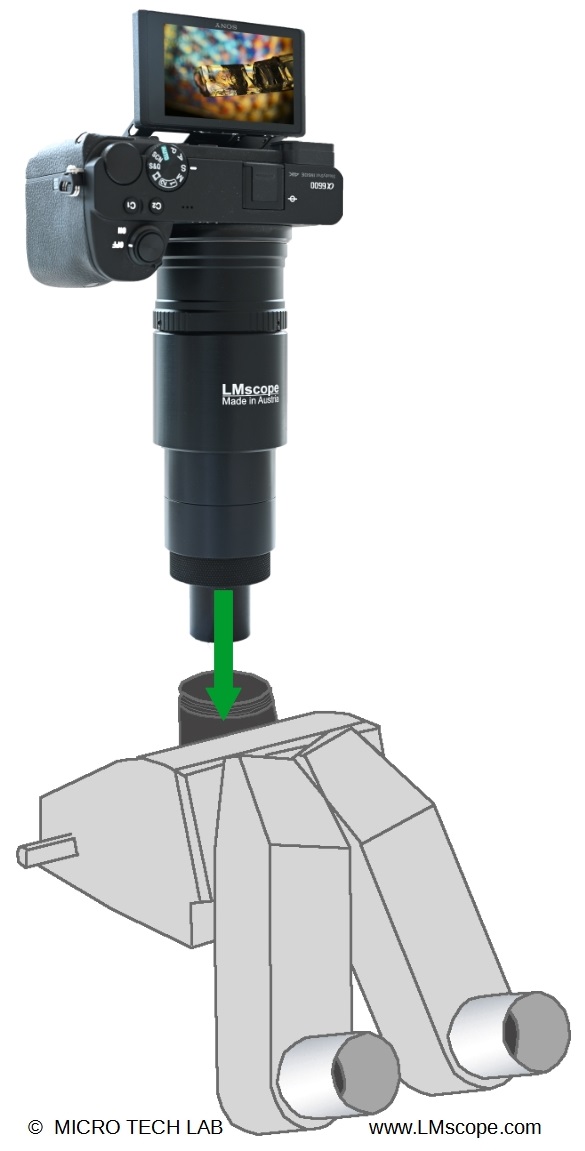
Tube no. 10 445 925 Tube no. 10 446 310
This is used as the basis for our LM adapter solutions with integrated precision optics. Depending on the camera brand and sensor dimensions, we offer different solutions for this type of connection.
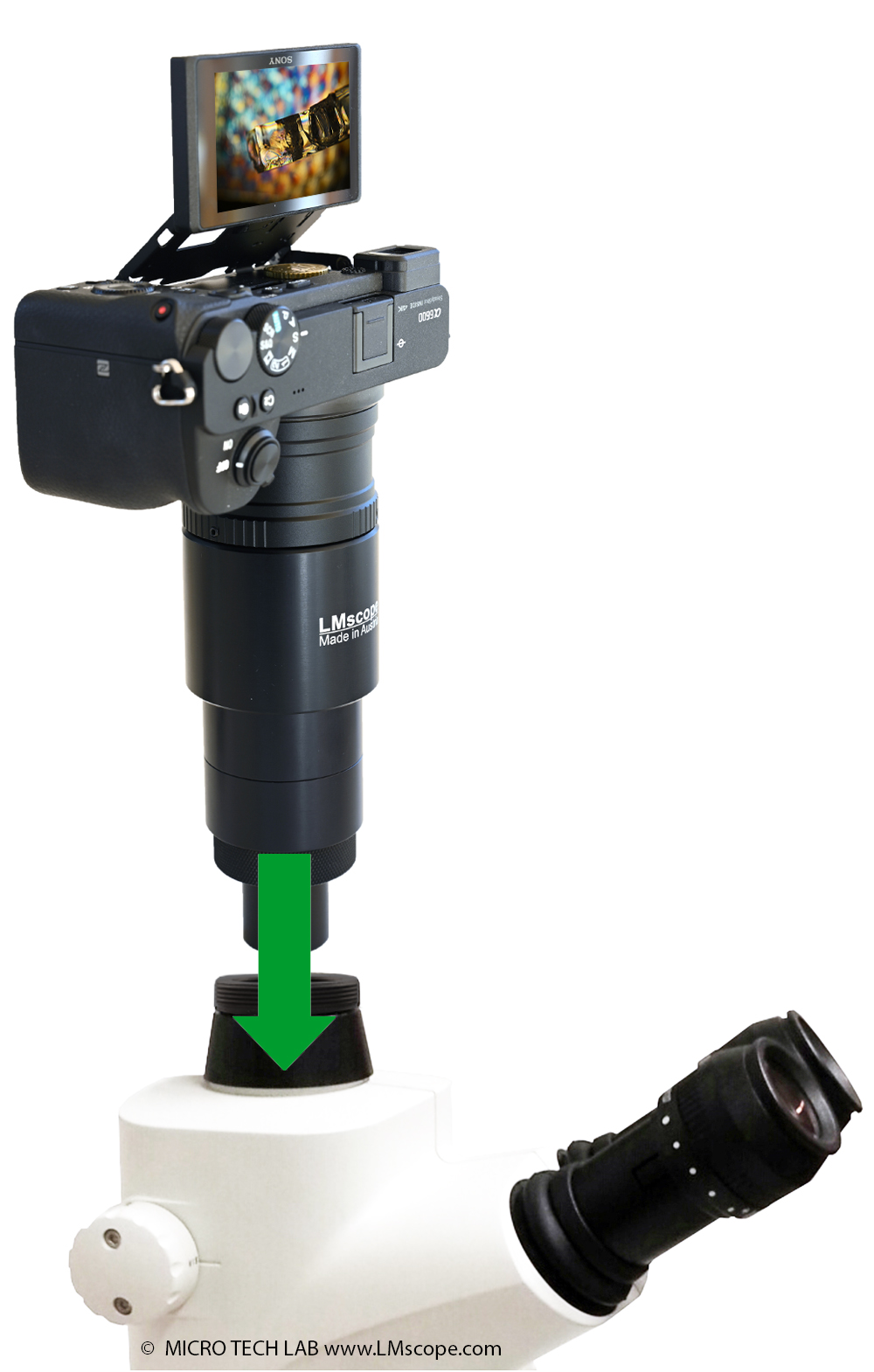
As the M series is a continuation of the Wild Heerbrugg series of microscopes, optical components from Wild (beam splitter no. 180570) are often used in conjunction with the M series microscopes, although they are not 100% compatible. This lack of compatibility manifests in suboptimal optical quality: there may be peripheral darkening and a loss of sharpness towards the edge of the image. The only possible solution would be to use a powerful C-mount port (e.g. 0.7x instead of 0.5x to for C-mount cameras).
As an alternative, the camera can also be attached to the eyepiece tube. To attach the camera, one of the microscope’s eyepieces is removed and the camera-adapter combination is put in its place. The M series microscopes come with a 45 degree binocular tube as standard. Alternatively, a 45 degree ergotube, a binocular ergotube and a so-called straight tube (vertical eyepieces) are available as well. For these tubes, we can offer an adapter solution where one eyepiece is removed and the adapter-camera unit is put into its place. This adapter solution is very flexible, because it can also be used on other microscopes with standard-sized eyepiece tubes (23.2 mm and 30 mm). It should be noted, however, that this configuration limits the user to a single eyepiece for direct observation. The optical quality achieved with this method is very good and matches that of a phototube adapter solution.
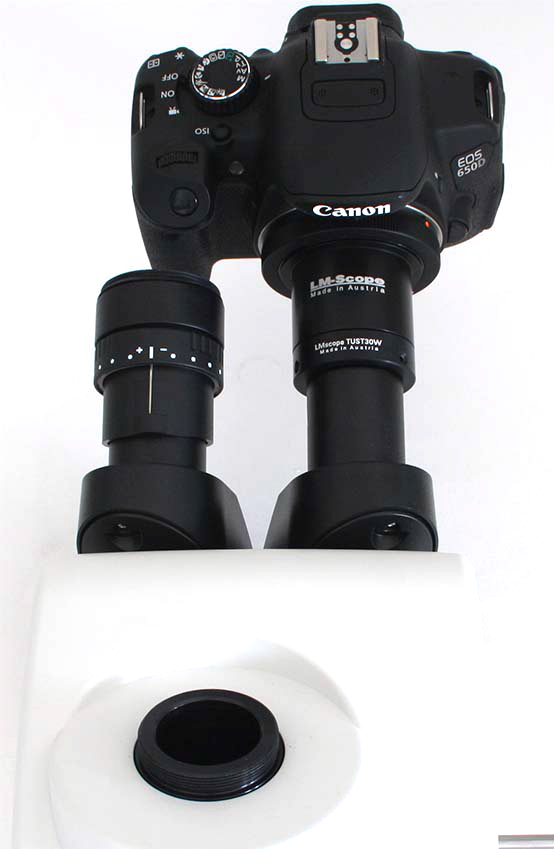
Thanks to the modular design of the M series microscopes, there are a wide range of different bases to select from. Different types of stages (gliding, ball-and-socket, rotary polarisation stage, etc.), a drawing tube for right- and left-handed users and a discussion tube for two observers are available as well.
For more information on making a camera selection, please refer to the page with our current camera recommendations. We are also happy to provide personalised advice, so please do not hesitate to contact us.
Conclusion: The Leica M series microscopes are established stereomicroscopes with high-quality imaging capabilities. With our LM digital adapters, powerful contemporary cameras can be attached to these microscopes both via the phototube and the eyepiece tube, making them superior instruments for capturing microscopic images of the highest quality.
19.01.2024Photography:
Fitting the microscope to digital single-lens reflex (DSLR), mirrorless interchangeable-lens cameras (MILC ), digital single-lens mirrorless (DSLM) or C-mount cameras is easy with our LM digital SLR adapters, which feature a plan achromatic optical system. Our products make it possible to capture top-quality microscope images. To help you select the adapter that is right for your camera, we have set up an online configurator on our website. You can also email us – ideally with attached photographs of your microscope.
Modern DSLR and single-lens mirrorless (DSLM) offer the latest technology and are generally very well suited for microscopy applications. Most of them can be controlled remotely via PC/Mac. Because of their high sales volumes, they offer an excellent price/performance ratio compared to special-purpose microscope cameras.
Features of top DSLR and single-lens mirrorless cameras (DSLM):
- Large, powerful full-frame sensors (36 x 24 mm)
- Sensor resolution of 61 megapixels or 240 megapixels with Pixel Shift technology
- High light sensitivity (ISO 400,000+)
- Extensive dynamic range (up to 15 aperture stops/f-stops)
- Short exposure times (1/8000 second) up to 1/32,000 seconds using the digital shutter
- 4K Ultra HD or 8K Ultra HD video function
- Live video capture on external monitors in ultra HD quality
In most cases, these cameras are significantly more powerful than microscope cameras with smaller sensors (1/2" or 2/3"). On our website you will find our current camera recommendations and a camera ranking which is specifically tailored to microscopy applications.